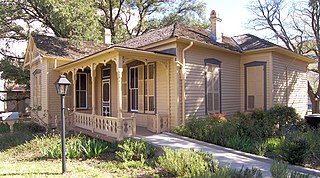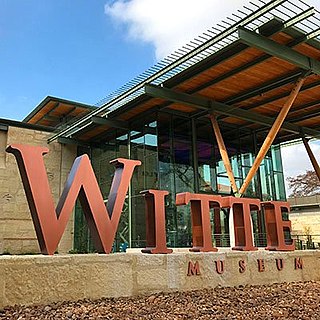
William Sydney Porter, better known by his pen name O. Henry, was an American short story writer. His stories are known for their surprise endings.

Maverick County is a county located in the U.S. state of Texas. As of the 2010 census, its population was 54,258. Its county seat is Eagle Pass. The county was created in 1856 and organized in 1871. It is named for Samuel Maverick, cattleman and state legislator.

Katherine Anne Porter was an American journalist, essayist, short story writer, novelist, and political activist. Her 1962 novel Ship of Fools was the best-selling novel in America that year, but her short stories received much more critical acclaim.

Henry Barbosa González was an American Democratic politician from the U.S. state of Texas, who represented Texas's 20th congressional district from 1961 to 1999.
Claude William Black, Jr. was an American Baptist minister and political figure. Black was born in San Antonio, Texas, which was segregated at the time. Black's parents are Claude Sr., who served as the Vice President of the Brotherhood of Sleeping Car Porters, and Cora Black, who was a housewife.
Fannie Porter was a well-known madam in 19th-century Texas, in the United States. She is best known for her association with famous outlaws of the day and for her popular San Antonio brothel.

The William Sidney Porter House or O. Henry House is a historic structure in Downtown Austin, Texas. William Sidney Porter, better known as the author O. Henry, lived there between 1893 and 1895. The Porter house was added to the National Register of Historic Places on June 18, 1973. The house is known today as the O. Henry Museum. The collection is curated by Melissa Parr, Site Coordinator.

The culture of San Antonio reflects the history and culture of one of the state's oldest and largest cities straddling the regional and cultural divide between South and Central Texas. Historically, San Antonio culture comes from a blend of Central Texas (Southern) and South Texas (Southwestern) culture. Founded as a Spanish outpost and the first civil settlement in Texas, San Antonio is heavily influenced by Mexican American culture due to Texas formerly being part of Mexico and, previously, the Spanish Empire. The city also has significant German, Anglo, and African American cultural influences. San Antonio offers a host of cultural institutions, events, restaurants and nightlife in South Texas for both residents and visitors alike.

Downtown San Antonio is the central business district of San Antonio, Texas, United States. It also serves as the urban core of Greater San Antonio, a metropolitan area with nearly 2.5 million people. In addition to being encircled by Loops 1604 and 410, Downtown San Antonio is encircled by three Interstate freeways: I-35, I-37, and I-10. Together, the three highways create a rectangular route around the city's urban core: I-35 to the north and west, I-37 to the east, and I-10 to the south. The rectangular loop has a nine-mile circumference and is known as the "Downtown Loop" or "Central Loop", which encompasses both it and Southtown.
George Rodney Willis, was an American architect associated with the Prairie School and the Oak Park, Illinois studio of Frank Lloyd Wright who thereafter had a successful career in California and in Texas.

The Witte Museum was established in 1926 and is located in Brackenridge Park in San Antonio, Texas. It is dedicated to telling the stories of Texas, from prehistory to the present. The permanent collection features historic artifacts and photographs, Texas art, textiles, dinosaur bones, cave drawings, and Texas wildlife dioramas, in addition to nationally acclaimed traveling exhibits. Artwork in the collection includes sculpture by San Antonio-born Bonnie MacLeary.

The Sporting District in the U.S. city of San Antonio, Texas was a red-light district in the late 19th and early 20th centuries. It was established by the city council to manage prostitution in the city. For a time it was one of the nation's largest vice districts with venues ranging from brothels to gambling halls. The area was officially shut down in 1941 resulting from the mobilization for World War II.
The City of San Antonio is one of the oldest Spanish settlements in Texas and was, for decades, its largest city. Before Spanish colonization, the site was occupied for thousands of years by varying cultures of indigenous peoples. The historic Payaya Indians were likely those who encountered the first Europeans.

O. Henry Hall, formerly known as the U.S. Post Office and Federal Building, is a historic courthouse and post office in Austin, Texas. It is located within the Sixth Street Historic District in Downtown Austin. O. Henry Hall serves as the administrative headquarters of the Texas State University System (TSUS), and until 2017 served as the University of Texas System headquarters.
Aline B. Carter (1892–1972) was a Texas poet and humanitarian, and Poet Laureate of Texas from 1947 through 1949. She also served as a vice president of the Poetry Society of Texas.

The Guenther House is a restaurant, museum and store located at 205 E. Guenther Street in the King William neighborhood of the Bexar County city of San Antonio in the U.S. state of Texas. Currently operated by C. H. Guenther and Son. Inc., the home was originally built as a private residence in 1859 by Pioneer Flour Mills founder Carl Hilmar Guenther. It was listed on the National Register of Historic Places listings in Bexar County, Texas on October 11, 1990.

The Edward Steves Homestead is located in the Bexar County city of San Antonio in the U.S. state of Texas. It was designed by architect Alfred Giles and designated a Recorded Texas Historic Landmark. The main house was donated to the San Antonio Conservation Society in 1952. The organization completely restored the main house as a museum and now conducts daily tours. The complete homestead property consists of four individual structures: the main house museum, the carriage house, the river house, and the servants' quarters. It is listed on the National Register of Historic Places listings in Bexar County, Texas, as a contributing structure of the King William Historic District.

The following is a timeline of the history of the city of San Antonio, Texas, United States.

The O. Henry House Museum is a historic house museum located in San Antonio, Texas. It is named for the American writer, William Sydney Porter, better known as O. Henry who lived in the house in 1885.
John William Goode Jr. was a lawyer in San Antonio who was a figure in the 1950s and 1960s rebirth of the Republican Party in Texas.













